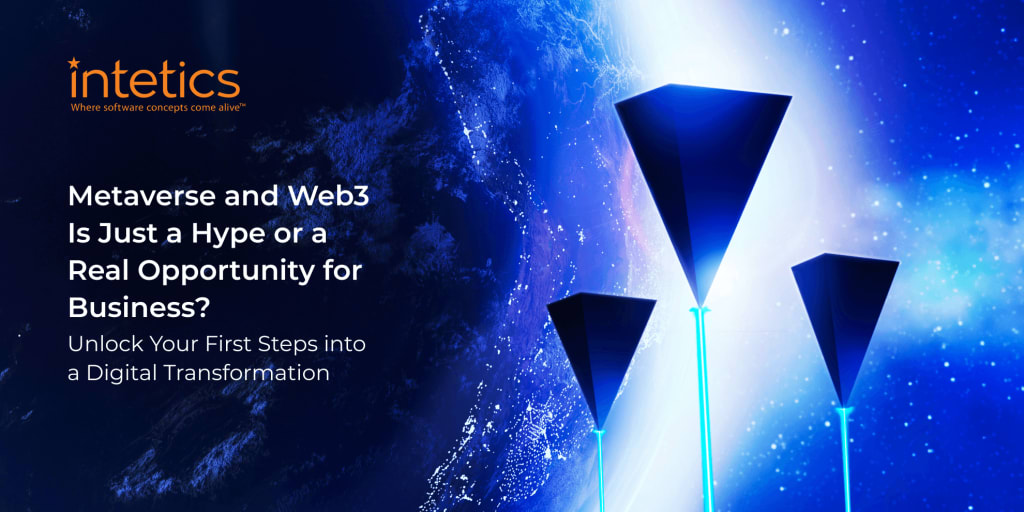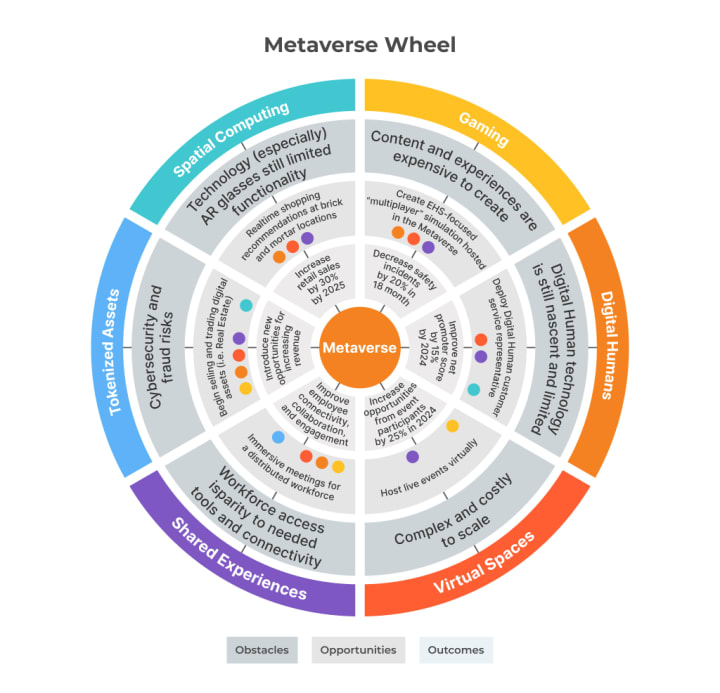Metaverse and Web3 Is Just a Hype or a Real Opportunity for Business? Unlock Your First Steps into a Digital Transformation
What is a metaverse? Why is there hype around it? Which innovations make metaverse a strategic technology trend for 2023 and beyond? Find the answers in the article and learn how businesses can explore the metaverse opportunities and navigate the hype vs. reality.

McKinsey report states that the Metaverse is too big for companies to ignore, with its potential to generate up to $5 trillion in value by 2030. More than ever Metaverse and Web3 play a vital role in the modernization of our society, transforming not only individuals but also corporates and companies into a digital world. Businesses are facing a whole new world of opportunities: game-changing innovation and the opportunity to shape the future through digital technologies.
In the recent report, Gartner outlined the top 10 strategic technology trends for 2023 that both business owners and IT leaders should exploit in the next 36 months. Explore the Gartner list of trends to watch in 2023:
- Digital Immune System
- Applied Observability
- AI Trust, Risk and Security Management (AI TRiSM)
- Industry Cloud Platforms
- Platform Engineering
- Wireless-Value Realization
- Superapps
- Adaptive AI
- Metaverse
- Sustainable Technology
Find out one the review of those ten trends, which now became a scorching topic for global business leaders, analysts, and investors — the Metaverse.
Gartner shows that by 2027, over 40% of large organizations worldwide will be using a combination of Web3, spatial computing, and digital twins in metaverse-based projects to increase revenue. Analysts also expect that by 2026, 25% of people will spend at least one hour a day in a metaverse for work, shopping, education, social media, and entertainment.
It’s crucial for businesses and individuals to stay ahead of the curve and understand the potential opportunities and challenges it could bring. 2023 is going to be the year of the metaverse and it’ll be completely game-changing.
Metaverse Explained
The Metaverse is more than just a single, established entity. It represents a bustling and crowded environment of technologies, tools, and vendors.
It’s better to start the explanation of the metaverse by outlining what it really isn’t. Metaverse is not just a virtual or augmented reality. It currently refers to a collection of emerging technologies that offer advanced levels of interaction in the virtual and physical worlds. Additionally, the metaverse is not tied to a specific device or controlled by a single company but is enabled by digital currencies and NFTs, comprising an independent virtual economy.
Gartner provides the following definition of the metaverse: A collective, virtual, shared space created by the convergence of virtually enhanced physical and digital reality. A Metaverse is persistent, providing enhanced immersive experiences.
The Vocabulary of Emerging Technologies by Intetics, defines Metaverse as a virtual 3D world where people can interact with a computer-generated environment and other users. Popular blockchain-based environments that comprise the Metaverse include Decentraland and The Sandbox, virtual gaming worlds where users can buy and sell land as NFT.
Simply put, the concept represents the next level of interaction in the virtual and physical worlds.
Key Innovation Making Metaverse a Strategic Trend for 2023 and Beyond
To understand why metaverse got on the list of top strategic trends for 2023, let’s examine the three critical, innovative technologies surrounding it along the way to building a digital future. They are Web3, Digital Twins, and Spatial Computing.
- Web3 refers to a new stack of technologies that allow for the development of decentralized web applications, giving users control over their identity and data. Combined with the metaverse concept, it creates an ecosystem where value is exchanged between individuals or organizations. Use these definitions of Web1, Web2, and Web3 for your reference:
- Web1 is commonly known as the World Wide Web. The first iteration of the web is referred to as the “read only web.” Web1 was characterized by static websites that displayed information. There was little to no user interaction or user-generated content.
- Web2 starting in the 90s, the “read-write web” is characterized by user-generated content and improved user interfaces. This led to the creation of blogs, social media platforms, and sites like Wikipedia and YouTube. Web2 placed more emphasis on user experience and interoperability between different applications and websites, giving us the vast network of connected websites and resources, we are familiar with today.
- Web3 is the third generation of the evolution of web technologies. The next iteration of the web being ushered in as we speak, which leverages blockchain technology, open-source applications, and the decentralization of data and information. Web3 aims to remove control of the web from monopolistic tech companies and return data and content ownership to its users. Also referred to as "read-write-trust-web."
- Spatial computing is a technology stack that enables users to experience the intersection of the physical and digital worlds. It combines the processes and tools used to capture, process, and interact with 3D data. Components of spatial computing can include IoT, digital twins, ambient computing, augmented reality, virtual reality, and AI/ML.
- Digital Twins. Here are two terms to consider: DToP and DToC. The Digital Twin of a Person (DToP) is a synchronized, near-real-time representation of a unique individual, allowing them to be present in multiple places simultaneously in both digital and physical spaces. A Digital Twin of a Customer (DToC) is a subset of DToP. It is a dynamic virtual representation that simulates and learns to emulate and anticipate a customer’s behavior. Customers can be individuals, groups of people, or even machines.
As the technology industry continues to grapple with understanding the true nature and capabilities of the metaverse, more and more business leaders have begun to incorporate references to it in their communications with investors and business partners. Why is there so much excitement around the topic? Keep readding and find out the metaverse powerful use cases.
Use Cases Showing the Possibilities of the Metaverse for Companies
The metaverse has the potential to offer persistent, decentralized, and collaborative models, allowing organizations to expand their digital operations. Even now, opportunities within the metaverse are beginning to appear for companies and individuals:
- Automotive dealers use spatial computing and the AR cloud to showcase more options by digitally changing interior and exterior attributes in real time. For example, Fiat claims to have opened the first metaverse-powered dealership in Italy.
- JPMorgan Chase has become the first bank to enter the metaverse with a predicted market opportunity of $1 trillion, focusing on virtual real estate with Decentraland — one of the world’s most popular metaverse platforms.
- Virtual workspaces can improve engagement, collaboration, and connection for employees, including virtual meetings that are already a feature of hybrid work enabled by metaverse technologies. Microsoft opens the doors of the workplace Metaverse in Teams with its Mesh Avatars. With the feature, users can make virtual meetings personal, engaging, and fun—even with the camera off.
- Siemens has partnered with NVIDIA to create an industrial metaverse. Clients can use the immersive environment to collaborate in developing innovative engineering solutions and solving real-world problems involving digital twins, IoT, and real-time analytics.
- With the Metaverse capacity for training simulations, it can also be used as a space for games that train employees in hazards without exposing them to risks. Healthcare, transportation, corporate onboarding, customer service, and safety training are just a couple of examples where metaverse can add efficiency.
Brands of all sizes and from various sectors, like Nike, LVMH, Walmart, Adidas, Disney, Verizon, Hulu, Netflix, Starbucks, and others, are using different approaches to access the metaverse and monetize it.
How Business Leaders Can Leverage Metaverse for Their Digital Strategies
Business executives from all around the world are currently considering their metaverse strategies. But it's important to note that organizations must be cautious as it is still early to see which metaverse is viable for the long term. Anyways, it’s critical to learn how to identify metaverse-inspired opportunities to extract the maximum value of it. To develop a working strategy that incorporates metaverse technologies, you can take the following steps:
- Carefully consider investment in emerging metaverses, and implement a data governance, security, and privacy policy to protect customer and employee data.
- Investigate how metaverse technologies can improve existing digital businesses or lead to the creation of new products and services.
- Create metaverse products and solutions using a combination of different innovations, with the help of evaluating the current high-value use cases and picking up the best practices.
- Place a greater emphasis on maximizing the human experience, aimed at delivering positive value for consumers, end-users, and society.
Discover the opportunities, obstacles, and potential outcomes.

Bottom Line
The metaverse promises innovative ways for companies to build their digital future and improve their existing business models. Executives and IT leaders must consider the metaverse as a key trend that will provide opportunities and drive strategic business innovations beyond technology. Thereby, organizations should be careful and precise when investing in a specific metaverse-based project, as it is tricky to determine which are viable for the long term. Let’s discuss how, when, and why your business should get started on your innovative AI & AR/VR journey. With the right set of technologies, tools, and talented engineers and managers, we are ready to help you plan your metaverse investments for you to achieve success.
About the Creator
Intetics
Intetics is a leading global technology company focused on the creation & operation of effective distributed technology teams aimed at turnkey software product development, digital transformation, quality assurance, and data processing.
Enjoyed the story? Support the Creator.
Subscribe for free to receive all their stories in your feed. You could also pledge your support or give them a one-off tip, letting them know you appreciate their work.






Comments (1)
Metaverse and Web3 offer real business opportunities, not just hype. Embrace digital transformation to stay relevant and explore new possibilities.if you are looking for metaverse game development company. you can also visit our website or you can also click the link below https://www.brsoftech.com/metaverse-game-development.html